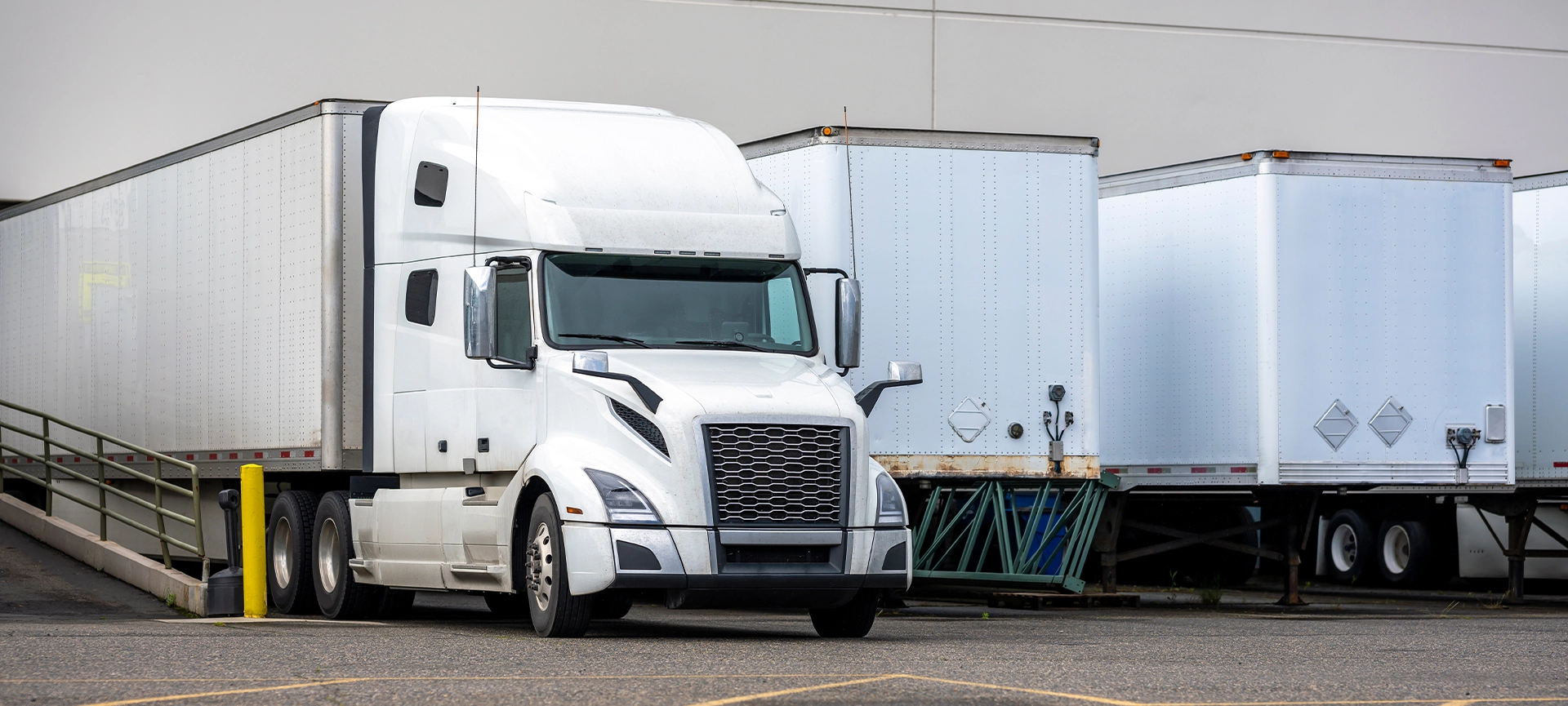Choosing between a reefer and a dry van trailer isn’t just about capacity. It’s about the kind of freight you’re moving, how far it needs to go, what conditions it needs during transit, and how much you want to spend. These two trailer types serve different purposes. A mismatch can mean spoiled cargo, late deliveries or added expense.
For business owners, truckers and logistics managers, understanding the differences between dry van vs. reefer shipping can be the difference between profit and loss. Especially for those moving temperature-sensitive goods, seasonal demand shifts or cross-border shipping with compliance regulations. From fuel costs to freight flexibility, each trailer type has its pros and cons that need to be matched to your operation.
Whether you manage a large fleet or small shipments, your choice affects delivery reliability, customer satisfaction and margins. Let’s break down what each trailer does best, where each falls short and how to decide which one is right for you.
Related Article: Difference Between Dry Van Freight and Flatbeds
What Is a Dry Van?
Dry vans are the backbone of North American freight. That’s because they’re the most widely used enclosed trailers for hauling non-perishable goods. Think of them as big, rectangular boxes on wheels. They seal up tight on all sides-and usually have rear doors for easy loading and unloading.
Those trailers are incredibly versatile. That’s why you’ll find them in use across retail, manufacturing and general consumer goods industries. Their enclosed design protects shipments from the elements—rain, dust, and theft. And that’s exactly what most shippers need.
Most dry vans are 53 feet long, but you can get them in other configurations depending on your needs. Without a refrigeration unit or insulation, they offer maximum storage space. But they do come with a limitation: they’re only good for goods that don’t require temperature control.
Common Goods Shipped in Dry Vans
- Electronics
- Furniture
- Clothing
- Packaged foods
- Paper products
- Household goods
- Machinery parts
For more on this type of transport, see dry van freight.
Dry vans are especially well-suited to companies using full truckload or LTL freight services, where affordability and general-purpose capacity are priorities.
What Are the Benefits of a Dry Van?
Dry vans are the gold standard for standard freight and for good reason. They’re simple and cost-effective for high volume shippers, small businesses and big supply chains. If your cargo doesn’t require temperature control, the dry van is a great value with minimal logistical overhead.
Key benefits include:
- Cost-effective for general freight: Dry vans have less operational demand than reefers, so lower shipping rates and maintenance costs.
- Enclosed and weather-tight: They’re solid against rain, wind and road debris so your cargo stays dry and intact.
- Easier maintenance and lower upkeep costs: No refrigeration unit or complex systems means less frequent servicing and downtime.
- Standard dock and facility compatible: Dry vans match standard warehouse loading dock heights, so shipping and receiving are a breeze.
- 53 ft long for maximum space: Most dry vans are 53 ft, so you have plenty of room to haul high volume or bulk items.
- Available in all freight markets: Whether you’re shipping across provinces or into the US, dry vans are available and flexible for any lane.
If your cargo is straightforward (think pallets of boxed goods, retail inventory or building materials), a dry van is a simple solution that balances capacity and cost.
Disadvantages of a Dry Van
While dry vans are popular, they aren’t for every shipment. Know their limitations to avoid delays, spoilage or damage, especially during seasonal weather changes.
Key drawbacks:
- No temperature control or humidity control: Dry vans are not suitable for perishables, pharmaceuticals or items affected by heat or cold.
- Internal condensation during humid conditions: Moisture can build up inside the trailer, especially when warm cargo is loaded into a cold trailer and can cause mildew or product degradation.
- Can’t carry perishable or sensitive goods: Dry vans don’t meet the standards for items that require a controlled climate.
- Extra packing required to avoid movement or damage: With no built-in restraints or airflow management, items must be packed securely to avoid shifting during transit.
- Vulnerable to extreme external temperatures, product integrity affected: In winter or summer extremes, a dry van offers no insulation and can damage temperature-sensitive freight.
If you’re shipping fragile electronics, delicate packaging or food-grade goods, a dry van may not provide enough environmental stability. In those cases, reefer or even heated transportation might be a better option.
Related Article: Train vs. Truck Freight Efficiency: Pros and Cons of Shipping

What Is a Reefer?
A reefer trailer (short for refrigerated trailer) is a temperature-controlled unit used to haul perishable or sensitive goods. These trailers have built-in cooling systems powered by diesel or electric. Unlike dry vans, reefers can maintain a specific temperature range throughout the trip.
In addition to cooling, many reefer trailers can also heat cargo in cold weather. This makes them perfect for cross-border or coast-to-coast shipments where temperature fluctuations are a concern.
From pharmaceuticals that need to stay within a narrow temperature range to seasonal produce that needs to stay fresh, reefers ensure product integrity upon arrival.
Common Goods Shipped in Reefers
- Dairy products
- Frozen foods
- Meat and seafood
- Pharmaceuticals
- Flowers and plants
- Vaccines
- Baked goods
Reefers are used by companies shipping food domestically and internationally. For example, those shipping food from Canada to the US need reefers to comply with US border regulations and food safety.
Advantages of Using a Reefer
Reefer trailers are built for reliability in tough shipping conditions. They are necessary for freight that can’t tolerate even a slight temperature or humidity fluctuation. Whether you’re moving frozen meat, floral arrangements, pharmaceuticals or live plants, a reefer trailer ensures your goods arrive fresh and intact.
Key benefits include:
- Maintains temperature settings: Reefers can be set to exact temperature ranges, from below freezing to room temperature, regardless of outside conditions.
- Can be used for heated transport too: In winter, reefers can be used as heated trailers to prevent freezing and product damage.
- Year-round delivery of seasonal products: Seasonal products like berries or seafood can be shipped anytime, helping businesses maintain supply regardless of weather.
- Higher revenue for specialty loads: Shippers pay more for temperature-controlled capacity, especially during summer or harvest seasons.
- Wider client base across industries: Reefers aren’t just for food. They’re used in medical, chemical, cosmetic and floral industries, opening up premium clients.
- Less spoilage and waste of high-value goods: With temperature monitoring, loss due to spoilage is minimized, preserving profit margins.
Reefers offer flexibility in temperature-controlled logistics. Whether you’re moving organic produce or high-end medical supplies, a reefer ensures compliance and consistency.
Benefits of a Reefer
Reefer trailers are built for reliability in tough shipping conditions. They are necessary for freight that can’t tolerate even a slight temperature or humidity fluctuation. Whether you’re moving frozen meat, floral arrangements, pharmaceuticals or live plants, a reefer trailer ensures your goods arrive fresh and intact.
Key benefits include:
- Maintains temperature settings: Reefers can be set to exact temperature ranges, from below freezing to room temperature, regardless of outside conditions.
- Can be used for heated transport too: In winter, reefers can be used as heated trailers to prevent freezing and product damage.
- Year-round delivery of seasonal products: Seasonal products like berries or seafood can be shipped anytime, helping businesses maintain supply regardless of weather.
- Higher revenue for specialty loads: Shippers pay more for temperature-controlled capacity, especially during summer or harvest seasons.
- Wider client base across industries: Reefers aren’t just for food. They’re used in medical, chemical, cosmetic and floral industries, opening up premium clients.
- Less spoilage and waste of high-value goods: With temperature monitoring, loss due to spoilage is minimized, preserving profit margins.
Reefers offer flexibility in temperature-controlled logistics. Whether you’re moving organic produce or high-end medical supplies, a reefer ensures compliance and consistency.
Related Article: What Is Refrigerated Shipping and How Does It Work?
Disadvantages of a Reefer
Reefers have many benefits but also more complexity. Their cooling systems require energy, expertise and maintenance. The initial cost and ongoing investment are more than dry vans.
Here are the downsides:
- Higher upfront and ongoing costs: Refrigeration units, insulation, and power systems add to the cost of buying and maintaining a reefer trailer.
- Complex systems that need regular servicing: Units need to be checked often for coolant levels, thermostat calibration and fuel efficiency. Neglect can damage cargo and cause repair downtime.
- Fuel for the refrigeration unit: These trailers burn more diesel to keep the goods cool (or warm), so more cost on long hauls.
- Less interior space due to insulation: Insulation reduces usable interior width and height compared to dry vans, slightly reducing payload volume.
- Temperature and hygiene compliance required: Especially for food and pharmaceuticals, reefers need to pass inspections and comply with sanitary transport regulations.
- Longer loading/unloading times due to inspection and regulation: Temperature checks and cargo validation can add to dwell time at docks and border crossings.
Because of the complexity, reefers are usually managed by experienced drivers and require more attention to detail in route planning and cargo handling. They are a good investment if your freight requires temperature control, but they also demand strict management to maintain profit and compliance.

Can You Use a Reefer as a Dry Van?
Yes, you can use a reefer as a dry van, but it’s not always the most cost-effective. The added weight of insulation and refrigeration equipment reduces the reefer’s payload, so it’s not as efficient when hauling dry freight only.
But in some cases, it’s worth it. If you’re moving electronics across Canada in January and can gently warm the inside of the trailer, it may prevent damage from freezing temperatures.
Running a reefer unit without activating the cooling system still burns fuel and requires maintenance. Over time, the wear on refrigeration components adds up and reduces the life of the trailer.
But in unpredictable climates or for carriers who want to maximize route flexibility, having a trailer reefer that can haul both refrigerated and dry loads may be worth the extra cost. It’s all about load flexibility vs operating costs.
Related Article: Dry Van Freight Rates 2025
Reefer vs. Dry Van: Key Differences
Here’s how dry van vs. reefer trailers compare on core specs:
Weight Capacity Comparison
| Trailer Type | Average Empty Weight | Max Load Capacity |
| Dry Van | 13,000 lbs | 45,000 lbs |
| Reefer | 15,000 lbs | 42,000 lbs |
Note: Reefer units weigh more due to cooling systems, reducing available load.
Trailer Dimensions Comparison
| Feature | Dry Van | Reefer |
| Length | 53 ft | 53 ft |
| Interior Width | ~100 inches | ~96 inches |
| Interior Height | 110 inches (avg) | 100 inches (avg) |
| Useable Volume | Higher (no insulation) | Slightly reduced |
For details, visit the 53-foot dry van trailer dimensions.

Freight Rates and Profitability
| Load Type | Average Rate per Mile | Influencing Factors |
| Dry Van | Lower | Fuel, market demand, volume |
| Reefer | Higher | Refrigeration fuel, special handling |
Reefer tends to command higher freight rates due to the complexity and care involved. But they also require more fuel and ongoing maintenance.
Reefer vs. Dry Van: Pros and Cons Table
| Feature | Reefer Trailer | Dry Van Trailer |
| Temp Control | Yes (cooling + heating) | No |
| Cargo Flexibility | High (dry + perishable) | Limited to dry goods |
| Maintenance Cost | High | Low |
| Freight Rate | Higher | Standard |
| Operating Complexity | Higher (requires training) | Lower |
| Common Use | Grocery, pharma, seasonal products | Retail, general freight |
Can You Use a Reefer as a Dry Van?
In the competitive freight market, flexibility is key. That’s why many fleets and owner-ops are considering using reefers for dry freight when temperature control isn’t needed. It seems like a no-brainer: haul temperature-sensitive freight when the market is hot and switch to dry loads when it’s not.
But there are trade-offs. Reefers are heavier and more complex than dry vans. That means reduced payload and higher fuel consumption even if the reefer isn’t running. If you’re only moving dry freight, you’re carrying the added cost and complexity of a reefer without using all the features.
Still, using a reefer as a dry van makes sense in some cases:
- During colder months, sensitive dry goods like electronics or chemicals may still need protection from freezing temperatures. In this case, reefer can run in heat mode.
- On mixed load routes, combining dry and chilled items in a reefer means better utilization and fewer empty miles.
- For long-haul lanes where outdoor temps can fluctuate wildly, the insulation alone offers extra cargo protection.
But for standard, year-round dry freight like consumer goods or paper products, a dedicated dry van is the more economical and maintenance-friendly option. Fleet managers should figure out how often they’ll need refrigeration to determine if running reefers full-time is worth the ROI.
Reefer vs. Dry Van for Owner-Operators
As an owner-operator, the choice between a reefer and a dry van will impact both income and lifestyle. Each trailer type has a different mix of responsibilities, earnings and scheduling demands.
Dry vans are the entry point for new drivers and independent operators. The trailers are easier to maintain, easier to load and generally have a more predictable schedule. Dry van work has fewer middle-of-the-night deliveries and less time waiting for temperature checks or dock inspections.
If you want to minimize stress and keep overhead low, dry vans are a solid, reliable revenue stream.
Reefer, on the other hand, offers higher-paying loads, especially during peak season. But the trade-off is more stringent delivery windows, longer dwell times at the dock and frequent cleaning and maintenance of the refrigeration unit. Missed temperature targets can also lead to rejected loads and liability.
From an income perspective, reefers can generate more revenue per mile but only if you’re disciplined with time management, unit upkeep and route planning. The added complexity also means there’s less room for error.
If work-life balance and lower startup costs are your priority, dry vans are the way to go. If you’re experienced, detail-oriented and chasing higher margins, reefers are worth the effort. Just make sure to weigh the long-term costs, not just the rate per mile.
Dry Van vs. Reefer vs. Flatbed
| Trailer Type | Best For | Learn More |
| Dry Van | General freight, boxed cargo | Dry van freight |
| Reefer | Temp-sensitive cargo | Refrigerated shipping |
| Flatbed | Oversized, irregular shipments | Flatbed freight |
Explore more on dry van vs flatbed.

Dry Van Trailer Shipping Costs
Cost elements include:
- Fuel
- Routine maintenance
- Driver pay
- Insurance
- Tolls and permits
- Tires and wear
Dry vans are widely available, making them cost-competitive for many lanes. Learn about full options on full truckload and LTL freight services.
Reefer Shipping Costs
Costs unique to reefers:
- Refrigeration fuel (diesel-powered units)
- Regular equipment checks
- Cleaning after perishable cargo
- Load temp tracking
- Higher insurance rates
- Emergency repairs and breakdowns
If you’re shipping perishables to the U.S., check our guide: shipping food from Canada to US.
Choosing the Right Equipment for Your Shipment
Use this list:
- Is the cargo perishable or temperature-controlled?
- What are the delivery time constraints?
- Do you have power or fuel for refrigeration?
- Is budget more important than control?
- Will freight be exposed to extreme temperatures?
- Are you shipping in winter or summer extremes?
- What are your driver training levels?
You might also want heated transportation for some loads in the winter months.
Connect With the Right Shipping Equipment
RoadLINX offers both reefer and dry van trailers as part of our customizable freight solutions. Whether you’re a business with specific requirements or a carrier looking for optimized equipment, we can help.
Get a quote today and keep your goods moving safely and efficiently with a trusted transport company in Canada.



